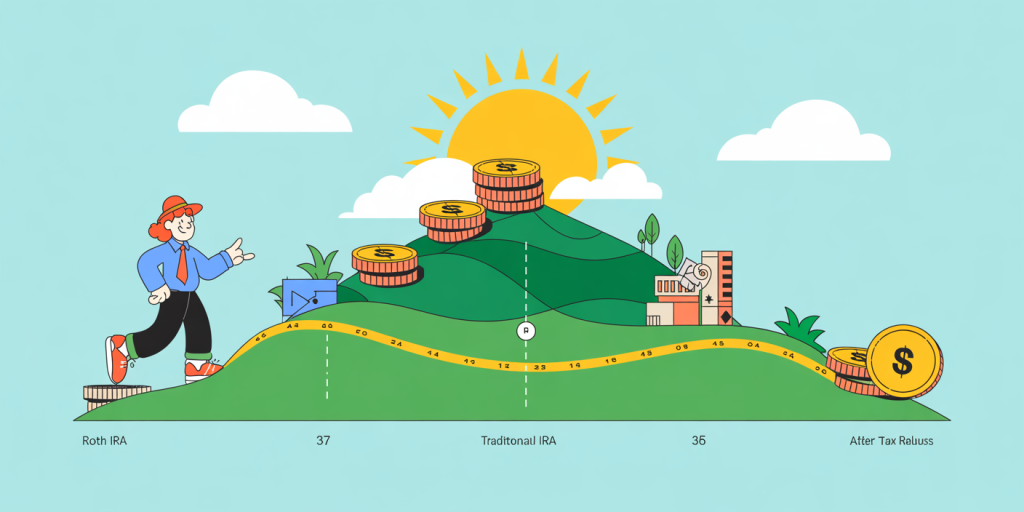Explained: Roth IRA vs. Traditional IRA – Which is Better for Your Retirement?
Anúncios
Planning for retirement is a crucial financial decision that impacts your lifestyle and security down the road. Among the various retirement saving vehicles, Individual Retirement Accounts (IRAs) are popular choices due to their tax advantages and investment flexibility. Two primary types of IRAs dominate the landscape: Roth IRA and Traditional IRA. While both provide tax benefits, their features differ significantly, influencing which one may be more suitable depending on your income, tax bracket, and retirement goals.
Understanding the distinctions between Roth and Traditional IRAs is essential for making an informed decision and optimizing your retirement savings strategy. This article delves deep into the core characteristics, tax implications, contribution rules, withdrawal strategies, and long-term benefits of both options. By evaluating real-world scenarios and statistical data, you will gain clarity on which IRA serves your financial future best.

Anúncios

What Are Roth IRA and Traditional IRA?
Both Roth and Traditional IRAs are personal retirement savings accounts designed to encourage long-term investing by offering tax advantages mandated by the IRS. The essential difference lies in the timing of their tax benefits.
Anúncios
A Traditional IRA allows contributions to be tax-deductible or made with pre-tax money depending on your income and retirement plan coverage. The funds grow tax-deferred, meaning taxes are not levied on earnings until distributions begin after age 59½. Withdrawals are taxed as ordinary income.
Conversely, a Roth IRA involves contributions made with after-tax dollars—meaning no immediate tax deduction. However, the account grows tax-free, and qualified withdrawals in retirement are exempt from federal income tax. To qualify for tax-free distributions, the Roth IRA must be held for at least five years, and withdrawals must occur after age 59½, or due to disability or first-time home purchase.
To put this in perspective, consider Sarah, a 30-year-old marketing professional in a 22% tax bracket. Choosing to invest $6,000 annually, she can either reduce her current taxable income by $6,000 if she opts for a Traditional IRA or pay taxes now and withdraw funds tax-free in retirement with a Roth IRA. Her decision will hinge on expected future tax rates and income needs during retirement.
Tax Treatment: When Do You Benefit Most?
Tax implications are often the deciding factor for retirement account selection. The Traditional IRA offers an upfront tax deduction on contributions. According to IRS data, for the 2023 tax year, individuals under 50 can contribute up to $6,500 annually, and those 50 or older can contribute $7,500. If you qualify, this reduces your taxable income immediately, providing liquidity benefits and potentially lowering your current tax bracket.
For example, John, a high earner in the 32% tax bracket, contributes $7,500 to his Traditional IRA, reducing his taxable income by that amount for the year. If he expects to be in a lower tax bracket during retirement, say 22%, deferring taxes until then could result in overall tax savings.
On the other hand, the Roth IRA offers no immediate tax break. Contributions are made with taxed dollars; however, the advantage is realized later, when withdrawals are tax-free. This can be particularly advantageous for younger savers or those who anticipate higher tax rates in retirement. The Tax Foundation reports that tax rates in the U.S. have been historically volatile and likely to increase due to rising federal debt levels, making tax-free withdrawals attractive in the long run.
An analysis by Fidelity Investments shows that individuals in their 20s and 30s tend to benefit more from Roth accounts due to potential tax bracket growth over their careers, while individuals closer to retirement or with higher current incomes may find Traditional IRAs more appealing for tax deferral.

| Feature | Traditional IRA | Roth IRA |
|---|---|---|
| Contribution Tax Impact | Tax-deductible contributions (if eligible) | Contributions after-tax (not deductible) |
| Earnings Growth | Tax-deferred | Tax-free |
| Withdrawals Tax | Taxed as ordinary income | Tax-free if qualified |
| Eligibility | No income limit for contributions (but deduction may be limited) | Income limits apply for contributions |
| Required Minimum Distribution (RMD) | Required starting age 73 | No RMD during owner’s lifetime |
Contribution Limits and Income Restrictions
Both IRAs have contribution limits governed by the IRS. For 2023, the maximum annual contribution is $6,500, or $7,500 for those aged 50 and above. However, these contributions are subject to income-based eligibility rules that vary between Traditional and Roth IRAs.
Traditional IRAs generally have no income limits on making contributions, but the tax deductibility phase-out begins if you or your spouse are covered by a retirement plan at work. For example, a single filer covered by a workplace pension with Modified Adjusted Gross Income (MAGI) above $73,000 will see a gradual reduction in the deductible amount until it phases out at $83,000.
In contrast, Roth IRAs impose direct contribution limits based on MAGI. For single filers in 2023, contributions phase out starting at $138,000 and are eliminated at $153,000. For married couples filing jointly, the phase-out range is $218,000 to $228,000. High-income earners may be restricted from contributing directly to a Roth IRA but could consider a “Backdoor Roth IRA” conversion strategy, which involves contributing to a Traditional IRA and then converting to Roth.
A practical example involves Mike and Lisa, a married couple earning $230,000 annually. They cannot contribute directly to Roth IRAs due to income limits but contribute to separate Traditional IRAs and convert to Roth IRAs to enjoy tax-free growth.
Withdrawal Rules and Penalties
Understanding withdrawal rules is vital to avoid unexpected penalties and tax liabilities during retirement.
Traditional IRAs require holders to begin taking Required Minimum Distributions (RMDs) at age 73 (raised from 72 by the SECURE Act 2.0 in 2023) to ensure the government eventually collects taxes on deferred earnings. The RMD amount is calculated based on the account balance and life expectancy. Failing to take RMDs results in steep penalties—up to 25% of the missed amount.
Early withdrawals (before age 59½) from Traditional IRAs are generally subject to a 10% penalty plus income tax unless an exception applies, such as first-time home purchase, qualified educational expenses, or disability.
Roth IRAs differ significantly. They do not require RMDs during the account owner’s lifetime, allowing funds to grow longer tax-free. Contributions (not earnings) can be withdrawn at any time without penalty or tax, offering enhanced liquidity. However, withdrawing earnings before age 59½ or before the five-year holding period may result in taxes and penalties unless qualifying exceptions apply.
These features make Roth IRAs appealing for individuals who want flexibility or anticipate needing funds for emergencies or other goals before retirement.
Investment Growth Examples Comparing Roth and Traditional IRAs
To illustrate how these accounts fare over time, let’s consider two investors, Emily and David, both aged 30, contributing $6,500 annually for 30 years with an average annual return of 7%. Emily invests in a Traditional IRA, deducting her contributions and paying taxes on withdrawals in retirement. Assume tax rate is 22% during contribution and 15% during withdrawal. David invests the same amount in a Roth IRA, paying taxes upfront at 22%, but withdrawals are tax-free.
| Metric | Traditional IRA (Emily) | Roth IRA (David) |
|---|---|---|
| Annual Contribution | $6,500 (pre-tax) | $6,500 (post-tax, $5,070 after tax) |
| Total Contributions | $195,000 | $152,100 (after taxes) |
| Account Value (30 years, 7% growth) | $585,000 (before tax) | $455,000 (tax-free) |
| After-Tax Value | $585,000 × (1 – 0.15) = $497,250 | $455,000 |
Although David contributes less after-tax, his Roth IRA’s tax-free growth and withdrawals effectively yield a higher net gain compared to Emily’s Traditional IRA after considering taxes on withdrawals.
This example highlights that Roth IRAs can be more advantageous for those who expect to be in equal or higher tax brackets in retirement, emphasizing the role of tax rate projections in account choice.
Planning for the Future: Choosing the Right IRA
The future of retirement planning necessitates flexibility, awareness of tax policy trends, and personal financial strategy alignment. With projections from the Congressional Budget Office indicating potential increases in federal taxation rates to address deficits, opting for a Roth IRA could hedge against higher future taxes.
Conversely, for individuals currently in high tax brackets but expecting lower income post-retirement—such as government employees or those with pensions—the Traditional IRA could leverage tax deferral to maximize savings.
Regulatory changes such as the SECURE Act 2.0 have also adjusted IRA rules—including increased RMD ages and higher catch-up contribution limits—emphasizing the need for savers to stay informed and adjust strategies accordingly.
Moreover, combining both Roth and Traditional IRAs can provide tax diversification, giving retirees more flexibility in withdrawal strategies and tax planning. For example, Alice uses a Roth IRA to cover unexpected expenses tax-free while drawing a steady income from her Traditional IRA.
By consulting with financial advisors and performing personalized tax bracket projections, savers can tailor retirement investments set for changing circumstances and maximize wealth accumulation.



Post Comment